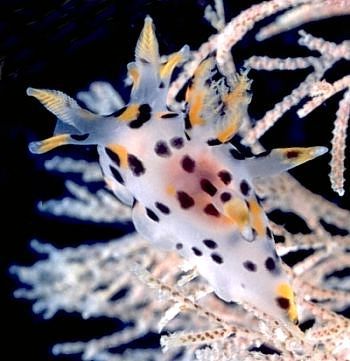
Thecacera pennigera
(Montagu, 1815)
Order: NUDIBRANCHIA
Suborder: DORIDINA
Family: Polyceridae
Subfamily: Polycerinae
DISTRIBUTION
Originally reported from the Atlantic coast of Europe, it is now known from South Africa, West Africa, Pakistan, Japan, Brazil, eastern Australia and New Zealand.
PHOTO
Thecacera pennigera on its food, the arborescent bryozoan Bugula, Port Hacking, Sydney, New South Wales, July 1982.
Photo: Bill Rudman.
Reference:
• Montagu, G. (1815). Descriptions of several new or rare animals, principally marine, discovered on the South Coast of Devonshire. Trans. Linn. Soc. London, 11: 1-26, pls. 1-5
• Valles, Y., Valdes, A. & Ortea, J. (2000) On the phanerobranch dorids of Angola (Mollusca, Nudibranchia): a crossroads of temperate and tropical species. Zoosystema, 22(1): 15-31.
Rudman, W.B., 1997 (December 19) Thecacera pennigera (Montagu, 1815). [In] Sea Slug Forum. Australian Museum, Sydney. Available from http://www.seaslugforum.net/find/thecpen
Related messages
Re: Thecacera pennigera - a new Mediterranean exotic
April 7, 2008
From: Constantine Mifsud
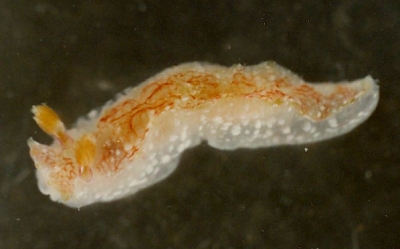
Concerning message #21483:
Dear Bill,
The Conchologial Society of Great Britain & Ireland have issued a postcard with a photo of a Thecacera pennigera taken at Portrush, Northern Ireland. I had thought the attached animal was this species. About 15 years ago I had found it attached to an old fishing line encrusted with with various marine fauna brought up from 60-80 m from Malta. Is it that species??
60-80 mteres, Malta, Mediterranean, summer 1993, hard substratum. Length: 24 mm. Photographer: C. Mifsud.
Constantine Mifsud
kejdon@orbit.net.mt
Mifsud C., 2008 (Apr 7) Re: Thecacera pennigera - a new Mediterranean exotic. [Message in] Sea Slug Forum. Australian Museum, Sydney. Available from http://www.seaslugforum.net/find/21493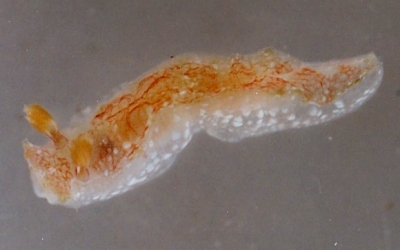
Dear Con,
From your photos my guess is that you have a tritoniid of some sort. The rhinophores seem to have vertical 'leaflets'. there seems to be an oral veil and possibly many tiny gills along the edge of the mantle.
With luck, someone may recognise it for us
Best wishes,
Bill Rudman
Re: Thecacera pennigera - a new Mediterranean exotic
April 1, 2008
From: Gary McDonald
Concerning message #21472:
Dear Bill:
Using my cross index I found the following mentions of Thecacera pennigera in the Mediterranean. Apparently all of the recent references cite much older references, with none mentioning recently seeing the species in the Mediterranean.
Fredol, Alfred. 1865. Le monde de la mer. Paris, L. Hachette et cie, vii + 632 pp, 22 pls.
[2nd ed, 1866 available at: http://ia360640.us.archive.org/1/items/lemondedelamer00fr/lemondedelamer00fr.pdf]
[I assume this is the book referred to below by both Carus, 1889-1893, & Cattaneo-Vietti & Chemello. 1987. I can read very little French, so I am not sure if the Fredol book says that the animal figured occurs in the Mediterranean; but perhaps this is the source of all the early citations of T. pennigera, in the Mediterranean?
pl. xviii, figs. 3-4, Polycere: shows an animal that looks like Thecacera pennigera.
Ihering, H. v. 1886. Beiträge zur Kenntniss der Nudibranchien des Mittelmeeres. II. 4. Die Polyceraden. Malakozoologische blätter, Neue Følge 8:12-48, pls. 1-2.
on p. 14:
Hinter jeder art gieft die Bezeichnung med. oder atl. an, ob die art im mittelmeer oder im atlant. Ocean gefunden ist...
Thecacera pennigera Mont. med., atl.
Carus, Julius Victor. 1889-1893. Prodromus Faunae Mediterraneae sive descriptio animalium Maris Mediterranei incolarum quam comparata silva rerum quatenus innotuit adiectis locis et nominibus vulgaribus eorumque auctoribus in commondom Zoologorum, vol. II. Brachiostomata, Mollusca, Tunicata, Vertebrata, ix + 854 pp.
on p. 227:
Th. pennigera Flem. Habit.: Sicilia (Quatrefages, in Fredol).
Vayssière, A. J. B. M. 1913a. Mollusques de la France et des régions voisines, tome premier, amphineures, gasteropodes opisthobranches, heteropodes, marseniades et oncidiides. Encyclopedie Scientifique, publiee sous la direction du Dr. Toulouse, Bibliotheque de Zoologie Doin, Paris, pp. 1-420, I-XII, pls. 1-37.
on p. 339, under the genus Thecacera:
Coloration blanche avec nombreuses taches irregulieres oranges et aussi grand nombre de punctuations noires repandues sur tout le corps, moins la face inferieure du pied; rhinophores et branchie plus ou moins oranges, avec des punctuations noires.
Formule radulaire 3,2,0,2,3.
Longueur 13mm sur 2.6 a 3mm de largeur
pennigera, Flem, Montagu.
Habitat. - Mediterranee: Sicile; Ocean: Ile Brehat, Wimereux, cotes de l'Angleterre.
Cattaneo-Vietti, R., & Giorgio Barletta. 1984. Elenco preliminare dei molluschi opistobranchi viventi nel Mediterraneo (Sacoglossa, Pleurobranchomorpha, Acochlidiacea, Aplysiomorpha, Nudibranchia). Bollettino Malacologico (Pubblicazione Mensile Edita dalla Societa Italiana di Malacologia) 20(9-12):195-218.
on p. 208:
** - Thecacera pennigera (Montagu, 1815) [the two asterisks indicate: "specie osservati molto raramente"].
Cattaneo-Vietti, R., & Renato Chemello. 1987. Alcune considerazioni sui molluschi opistobranchi della Sicilia. Bollettino Malacologico (Pubblicazione Mensile Edita dalla Societa Italiana di Malacologia) 23(5-8):207-222.
on p. 216:
Thecacera pennigera (Montagu, 1815) (Doris)
- fide Carus, 1889-93 (sec. Quadrefages in Fredol)
Cattaneo-Vietti, R., & Thomas Everett Thompson. 1989. Mediterranean opisthobranch molluscs: a zoogeographic approach. Bollettino Malacologico (Pubblicazione Mensile Edita dalla Societa Italiana di Malacologia) 25(5-8):183-204.
on p. 200:
CT Thecacera pennigera (Montagu, 1815) [Doris]
[the CT indicates Circumtropical region]
Cattaneo-Vietti, R., R. Chemello, & Ricardo Giannuzzi-Savelli. 1990. Atlas of Mediterranean nudibranchs [Atlante dei nudibranchi del Mediterraneo], 264 pp., 14 pls. La Conchiglia, Rome.
on p. 21:
Thecacera pennigera is in the list of species but is not treated in the body of the work.
Hope this is a step toward clearing up the early citations of Thecacera pennigera in the Mediterranean.
Best,
Gary
mcduck@ucsc.edu
McDonald, G., 2008 (Apr 1) Re: Thecacera pennigera - a new Mediterranean exotic. [Message in] Sea Slug Forum. Australian Museum, Sydney. Available from http://www.seaslugforum.net/find/21483Thanks Gary,
Best wishes,
Bill Rudman
Re: Thecacera pennigera - a new Mediterranean exotic?
March 27, 2008
From: Dani Barchana
Concerning message #21469:
Dear Bill
I can fully understand the frustration you feel, I thought the dark days of "not sharing information" were long gone, but it proves otherwise. I have checked the CIESM site and found no record to "Thecacera pennigera " in their archives (I can access it probably because I can do it through the Tel-Aviv University computing system).
If, anytime in the future, you shell need any access to the site - please let me know if could be of any assistance.
Cheers,
Dani
dani.barchana@gmail.com
Barchana, D., 2008 (Mar 27) Re: Thecacera pennigera - a new Mediterranean exotic?. [Message in] Sea Slug Forum. Australian Museum, Sydney. Available from http://www.seaslugforum.net/find/21473Thanks Dani,
Clearly the administrators have lost their way. The purpose of the site is to share and increase our knowledge not to collect a few euros. They even ask on the site for people to send in new records - why would I pay to do that?
But don't let me be diverted from your interesting find. Lucas Cervera [#21472] has noted an early reference from over 100 years ago, which may or may not be correctly identified, but I think we can say there has never been a resident population in the Mediterranean. It would be interesting to know if your animals are the result of shipping or are from larvae which has been washed through the Suez Canal. Certainly the size of the spots suggest it is from an Indo-West Pacific population, as animals from nthn Europe only have small numerous spots.
Best wishes,
Bill Rudman
Re: Thecacera pennigera - a new Mediterranean exotic
March 27, 2008
From: Juan Lucas Cervera
Concerning message #21469:
Dear Bill,
Many years ago I used the following Vayssière's reference:
VAYSSIÈRE, A. J. B. M. 1913. Mollusques de la France et des régions voisines, tome premier, amphineures, gasteropodes opisthobranches, heteropodes, marseniades et oncidiides. Encyclopedie Scientifique, publiee sous la direction du Dr. Toulouse, Bibliotheque de Zoologie Doin, Paris, pp. 1-420, I-XII, pls. 1-37. [Nudibranchia pp. 243-365].
Unfortunately it is not currently available to me. In this volume, it seems to me that Vayssière included a record of Thecacera pennigera from Sicily, but without bibliographic source of it. Probably, this record is the reason it has been included in the site of Italian Fauna (www.faunaitalia.it).
After this reference, I have no news of additional material collected from the Mediterranean. Of course, I cannot confirm the identity of Vayssiere's record.
Best.
Lucas.
lucas.cervera@uca.es
Cervera, J.L., 2008 (Mar 27) Re: Thecacera pennigera - a new Mediterranean exotic. [Message in] Sea Slug Forum. Australian Museum, Sydney. Available from http://www.seaslugforum.net/find/21472Thanks Lucas,
It's a bit hard to confirm early records like this, but I will have a look at Vayssiere's publication when I am next in the museum. I note that Pruvot-Fol (1953) does not include the Mediterranean in her distribution of the species.
-
Pruvot-Fol, A. (1954) Mollusques Opisthobranches. Faune de France, Paris 58: 1-460,Pl.1.
Best wishes,
Bill Rudman
Thecacera pennigera - a new Mediterranean exotic?
March 26, 2008
From: Dani Barchana
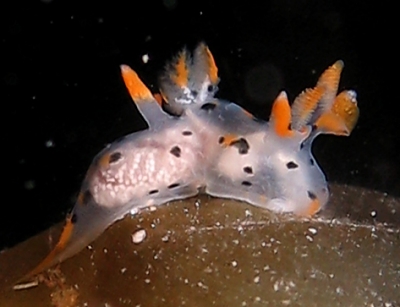
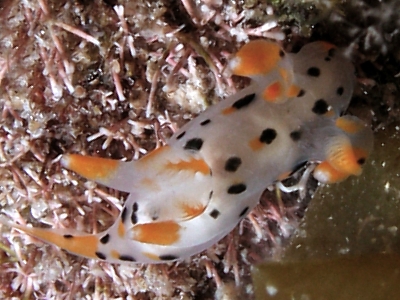
Concerning message #5212:
2 days ago, Tel-Aviv, I took some pictures of what my friend Benjamin Koretz (He is my guide book :-) ) identified as Thecacera pennigera.
It is the first time I have seen this beautiful creature.
Locality: Tel Aviv Beach, 6-7 meters, Israel, Mediterranean, 22 March 2008, reef. Length: 2.5 cm (approx.). Photographer: Dr. Dani Barchana.
Dani Barchana
dani.barchana@gmail.com
Barchana, D., 2008 (Mar 26) Thecacera pennigera - a new Mediterranean exotic?. [Message in] Sea Slug Forum. Australian Museum, Sydney. Available from http://www.seaslugforum.net/find/21469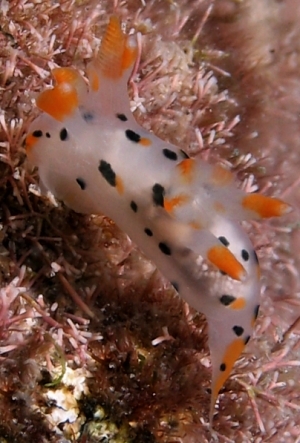
Dear Dani,
Thanks for this interesting discovery which I think is the first report of this species from the Mediterranean. A few years ago this species was reported from the tropical west African coast (Valles, Valdes & Ortea, 2000) but I know of no report of it from anywhere in the Mediterranean. Your find, at the eastern end of the Mediterranean suggests it may be a lessepsian immigrant, arriving via the Suez Canal.
On the Lessesian migration Fact Sheet I have a link to the Mediterranean Science Commission'sAtlas of Exotic Species in the Mediterranean Sea. In the past I have used this site to check earlier records of exotic opisthobranchs in the Mediterranean. Imagine my surprise when I received the following message when I tried to access it today:
"You have requested access to CIESM products that are delivered free of charge only to the Member States of our Commission that support our activities. For all other visitors like you, downloading from Australia, a participation fee (1.50 €) is applied for this product."
I thought the point of such websites was to spread information widely for the good of us all. What is particularly galling is that this site makes full use of the freely available results produced by scientists worldwide to produce their database. They have made extensive use of the Sea Slug Forum in the past and I am sure they will continue to do so. They have never asked for permission or offered to pay for this information so why should they expect me to pay to look at my own records when all I am trying to do is to further their aims. 1.50 € may seem a trifling amount so why do I complain? The whole purpose of such databases is to provide up to date information so to use them properly they need to be checked regularly - so every time I do this I will have to pay another 1.50 € and bank charges etc. What is the point in this government body charging? It will hardly generate enough funds to buy a bureaucrat a fancy chair! Government bodies such as CIESM should be encouraging the public to support their activities - which have already been paid for by the member governments. Surely the governing committee just by looking at the contributions to their site must realise that the expertise they need is to be found all around the world, not just in their member countries. More importantly, stupid and petty imposts like this completely destroy the aim of the internet to be a means for the fast and free exchange of information worldwide.
Sorry for overloading your message with my comments on the CIESM Dani, but it means I can't be 100% sure that there is not some very recent record of T. pennigera from the Mediterranean.
-
Valles, Y., Valdes, A. & Ortea, J. (2000) On the phanerobranch dorids of Angola (Mollusca, Nudibranchia): a crossroads of temperate and tropical species. Zoosystema, 22(1): 15-31.
Best wishes,
Bill Rudman
Re: Thecacera pennigera from Woods Hole
December 5, 2006
From: Alan Shepard
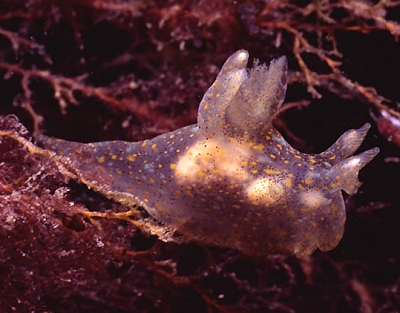
Concerning message #11532:
Bill -
After not finding Thecacera pennigera at Woods Hole, Massachusetts, USA in either 2004 or 2005 after its initial appearance in 2003 it has reappeared in great numbers in 2006. A friend knowing of my interest in the species notified me of its return a few weeks ago and I got the chance to dive the area last week.
Locality: Woods Hole, 8 metres, Massachusetts, USA, Atlantic Ocean, November 30, 2006, soft bottom strewn with boulders. Length: 20mm. Photographer: Alan Shepard.
A good percentage of any hard substrate was covered with the bryozoan Bugula which in turn were covered in Thecacera pennigera and egg masses. I assume that somehow the species had maintained a foothold in the area but not in great numbers in either 2004 or 2005 and that conditions were just right for the population explosion in 2006.
Best wishes,
Alan Shepard
Tolland, CT
alan.chepard@snet.net
Shepard, A., 2006 (Dec 5) Re: Thecacera pennigera from Woods Hole. [Message in] Sea Slug Forum. Australian Museum, Sydney. Available from http://www.seaslugforum.net/find/18899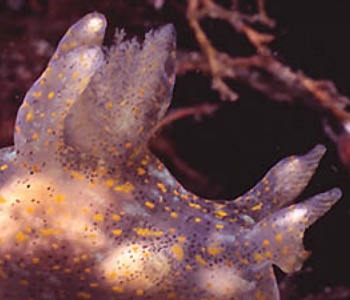
Dear Alan,
Thanks for keeping us up to date. It's interesting that all Atlantic records seem to be of this colour form with small orange spots and smaller dark blue specks. It also would be interesting to determine whether species like Thecacera, which appear irregularly like this, often in large numbers - apparently from nowhere, maintain a small foothold all the time, as you suggest, waiting for the food to appear in abundance, or whether they totally disappear after a 'boom'. Perhaps they reappear again as a larval swarm, travelling on a suitable current, and finding suitable food supplies, settle out of the plankton for another appearance. 'Population explosion' implies that there was a resident low level population present. Perhaps what you are witnessing is the visit of a 'travelling circus' which stops in your town when conditions are right and then moves on.
Best wishes,
Bill Rudman
Thecacera pennigera from eastern Australia
November 30, 2006
From: Leanne & David Atkinson
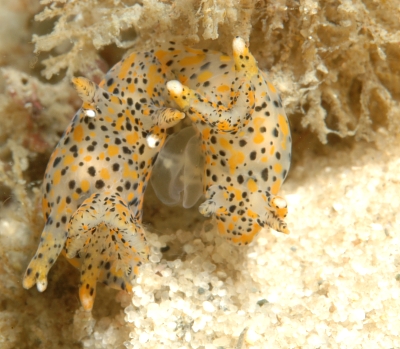
Hi Bill,
We found these Thecacera pennigera mating. They seem to be on their food. Thought these shots might be of interest. Water Temperature: 19 degrees celcius
Locality: Fly Point Marine Reserve Port Stephens , 10 metres, NSW Australia, Pacific, 12th November 2006, Sandy bottom with scattered sponges, ascidians, bryzoans soft corals and gorgonians.. Length: 15 to 20 mm. Photographer: Leanne & David Atkinson.
Regards,
Leanne & David Atkinson
atk@hunterlink.net.au
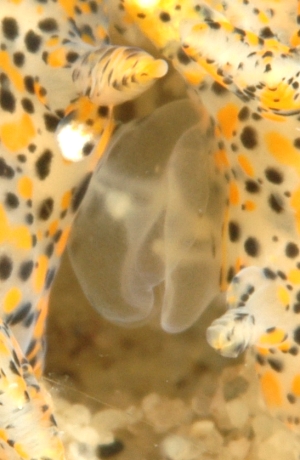
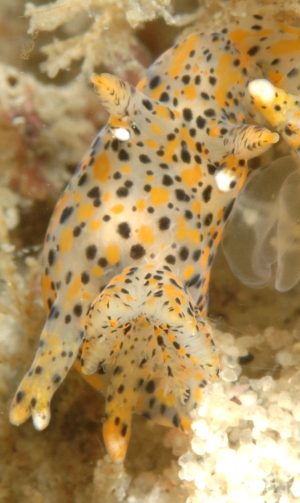
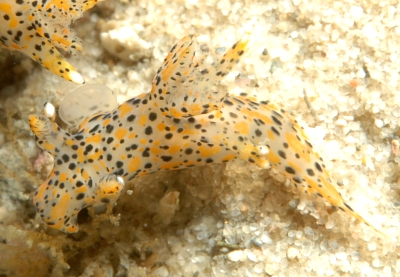
Dear Leanne & David,
Thanks for these interesting photos. The Thecacera certainly are on an arborescent bryozoan which is almost certainly their food. It is interesting to see two animals with this small-spotted pattern. The small-spotted pattern is the typical Atlantic colour form while in the Pacific larger spots seem more common.
Best wishes,
Bill Rudman
Thecacera pennigera from South Australia
June 20, 2005
From: Dennis Hutson
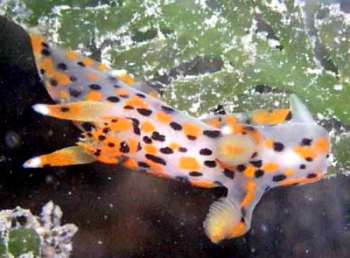
Can you please confirm this is Thecacera pennigera.
Locality: Outer Harbour, Adelaide, South Australia. Depth: 3 metres. Length: 12 mm. 18 June 2005. silty. Photographer: Dennis Hutson
Is it native to Adelaide, South Australia?
Cheers.
Dennis Hutson
dghutson@ozemail.com.au
Hutson D.G., 2005 (Jun 20) Thecacera pennigera from South Australia. [Message in] Sea Slug Forum. Australian Museum, Sydney. Available from http://www.seaslugforum.net/find/14077Dear Dennis,
Yes this is Thecacera pennigera. Your question about where it comes from is quite interesting. It was originally described from England so we have assumed that it is a North Atlantic species. However it has since been found in many parts of the world as you will see from the Fact Sheet and accompanying messages. It feeds on bryozoans which are part of the 'fouling community' a name for plants and animals which grow on hard surfaces, and in particular, the bottom of boats. We have assumed that this species has spread from the Nth Atlantic on the bottom of boats. However most species of Thecacera are found in the Indo-West Pacific region, and as you will see from looking at the photos on the Forum, there is much more colour variation in animals from the Pacific than from the Nth Atlantic. This could suggest that the Pacific is the original home of this species and what we now find in the Nth Atlantic is a population based on a few Pacific animals with small spots that were transported there on the bottom of sailing ships two centuries ago.
I guess this could be tested by DNA analysis.
Best wishes,
Bill Rudman
Thecacera pennigera from Senegal
June 20, 2005
From: Marina Poddubetskaia
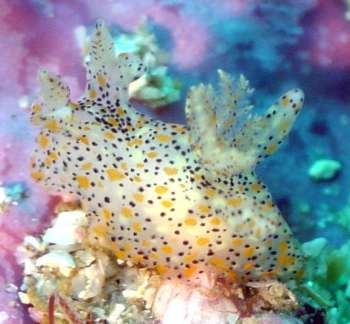
Dear Bill,
Here is a record of Thecacera pennigera from Dakar. I saw this species in large numbers but at only one place full of the bryozoan like in second photo.
Locality: 'Iles de la Madeleine', Dakar, Senegal. Atlantic Ocean. Depth: 7 m. Length: 13 mm. 29 May 2005. Photos: Marina Poddubetskaia - Nembro website
Cordially,
Marina.
nembro@nembro.info
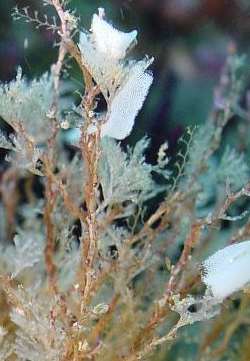
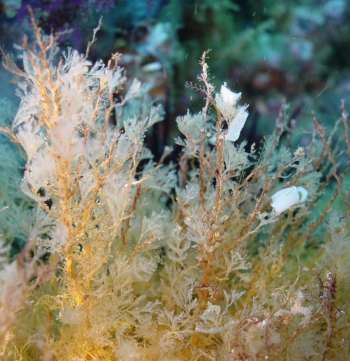
Dear Marina,
Your message arrived just as I was posting one on an animal from South Australia [message #14077]. Your animal certainly illustrates just how uniform is the colour pattern of Atlantic animals compared with those populations from the Pacific.
I am not an expert on bryozoans but your photo looks quite similar to the one identified as Bugula plumosa in Picton & Morrow (1997).
Best wishes,
Bill Rudman
Additional record of Thecacera pennigera from Florida
May 5, 2005
From: Jeff Goddard
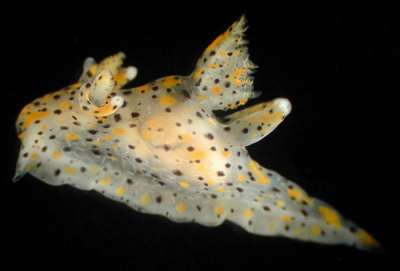
Hi Bill,
Kevin Johnson, a friend of mine who teaches at the Florida Institute of Technology, and his Biological Oceanography students recently found this specimen of Thecacera pennigera at the mouth of Sebastian Inlet, on Florida's Atlantic coast.
Kevin asked me to identify the specimen, and by luck I recognized the color pattern from my previous browsing of Thompson and Brown's (1984) monograph on British nudibranchs.
Locality: mouth of Sebastian Inlet, Florida, USA. Atlantic Ocean. Depth: Low intertidal. Length: 7.5 mm. April 2005. rocky/sandy. Photographer: Kevin Johnson
I thought that Kevin's photograph would complement Colin Redfern's 2003 message [#11513 ] concerning Kerry Clark's records of this species from Florida, which were apparently from the same locality.
Best wishes,
Jeff Goddard
goddard@lifesci.ucsb.edu
Goddard, J.H.R., 2005 (May 5) Additional record of Thecacera pennigera from Florida. [Message in] Sea Slug Forum. Australian Museum, Sydney. Available from http://www.seaslugforum.net/find/13712Thanks Jeff,
It's certainly nice to get another record. A photo showing the colour form is certainly better than a name on a list.
Best wishes,
Bill Rudman
Thecacera pennigera laying eggs - Woods Hole
December 4, 2003
From: Alan Shepard
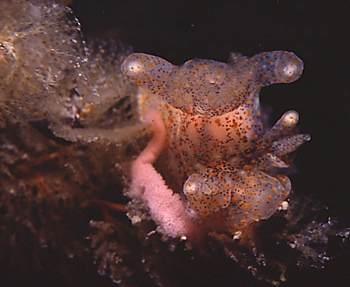
Bill -
I know you are always interested in photos of nudibranchs actually doing something. Here is a photo of Thecacera pennigera from Woods Hole, Massachusetts, laying eggs. At least that's what I assume was going on.
All the egg strands I found were white but from time to time I encountered some that were pinkish. I assume that the pink coloration indicates that they were newly laid and that they turn to the white color after a time. I could be wrong on that though.
Best wishes,
Alan Shepard
Tolland, CT, USA
alan.chepard@snet.net
Shepard, A., 2003 (Dec 4) Thecacera pennigera laying eggs - Woods Hole. [Message in] Sea Slug Forum. Australian Museum, Sydney. Available from http://www.seaslugforum.net/find/11590Dear Alan,
This is an interesting addition to your earlier messages on these animals from Woods Hole. The eggs of quite a few species show a colour change as they develop but I am not sure if those of Thecacera pennigera have been reported to do so.
Best wishes
Bill Rudman
Thecacera pennigera from Woods Hole
November 28, 2003
From: Alan Shepard
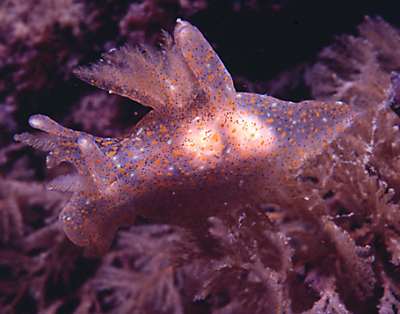
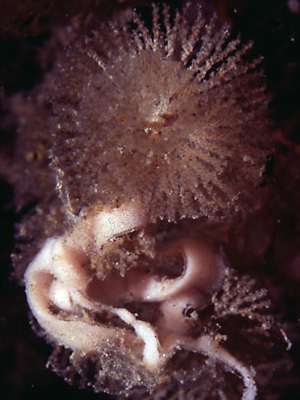
Bill -
Following my recent visit, I returned to Woods Hole, Massachusetts to get a better photograph(s) of Thecacera pennigera and to see just how many I could find. I did three dives of about 50 minutes each and came across 40 to 50 separate individuals. The largest was approximately 30mm long (photo attached) while the smallest was about one-half that size. The majority were of the larger size. The easiest way to find them was to find an egg strand (photo attached) and then usually a specimen or two would be close by. Water temperature that day was about 7c. I've notified the local experts and they've found the discovery of interest and may do some investigating on their own.
Best wishes,
Alan Shepard
Tolland, CT, USA
alan.chepard@snet.net
Shepard, A., 2003 (Nov 28) Thecacera pennigera from Woods Hole. [Message in] Sea Slug Forum. Australian Museum, Sydney. Available from http://www.seaslugforum.net/find/11532Thanks Alan,
It will certainly be interesting to see how long they stay, and whether they return with any regularity.
Best wishes
Bill Rudman
Re: Thecacera pennigera from Woods Hole
November 26, 2003
From: Colin Redfern
Dear Bill,
In response to your query regarding Kerry Clark's 1995 reference to Thecacera pennigera, he listed the occurrence of this species as "rare or sporadic" at Sebastian Inlet on Florida's East coast in 1972-80, but found it to be "apparently absent" at that location in 1985-1994.
Best regards,
Colin
bahamianseashells@att.net
Redfern, C., 2003 (Nov 26) Re: Thecacera pennigera from Woods Hole. [Message in] Sea Slug Forum. Australian Museum, Sydney. Available from http://www.seaslugforum.net/find/11513Thanks Colin,
Nice to have that sorted out
Bill Rudman
Re: Thecacera pennigera from Woods Hole
November 25, 2003
From: Alan Shepard
Bill –
Concerning your query about references. I found two references to Thecacera pennigera being present in Florida. The first was on the web site of the Smithsonian Marine Station in Fort Pierce, Florida. Their web site can be found at:
http://www.sms.si.edu/IRLSpec/Tspecies.htm
The second was on the Western Atlantic Gastropod Database site found at:
http://erato.acnatsci.org/wasp/search.php/10658
I had contacted Dr. Larry Harris at the University of New Hampshire and he did indicate it was indeed a first for our area.
The dive site is in the area of some heavy shipping. The Woods Hole Oceanographic Institute's vessels and U.S. Coast Guard vessels are all docked nearby not to mention local ferries and numerous pleasure craft so I wouldn't be surprised if the appearance was the result of some hitchhiking.
There are always species of Bugula in our waters however prior to the recent dive I had never seen an entire dive site so covered in them. I'm heading back to the site to hopefully get some better photographs of the creature.
Best wishes,
Alan Shepard
alan.chepard@snet.net
Shepard, A., 2003 (Nov 25) Re: Thecacera pennigera from Woods Hole. [Message in] Sea Slug Forum. Australian Museum, Sydney. Available from http://www.seaslugforum.net/find/11468Thanks Alan,
I see the Western Atlantic Gastropod Database has:
Distribution: USA: East Florida; Brazil: Sao Paulo.
References: Er. Marcus (1957) SM; Platts (1985) E; Thompson (1988) ds; Clark (1995) NW
I guess that means the Platts, Thompson, and Clark references refer to records from Florida. However Platts (1985) only includes records from the North Sea region so I don't know why its included in the database. It is possible that Kerry Clark's paper is relevant but I don't have a copy available. If anyone does it would be interesting to see if it mentions Thecacera from the Florida. Unfortunately I can't track down their Thompson reference:
• Clark, K. B. 1995. Rheophilic/oligotrophic lagoonal communities: throught the eyes of slugs (Mollusca: Opisthobranchia). Bulletin of Marine Science, 57: 242-251
• Platts, E. 1985. An annotated list of the North Atlantic Opisthobranchia (excluding Thecosomata and Gymnosomata): a tribute to Dr Henning Lemche. Ophelia, Supplement 2: 150-170.
Best wishes,
Bill Rudman
Thecacera pennigera from Woods Hole, Massachusetts
November 21, 2003
From: Alan Shepard
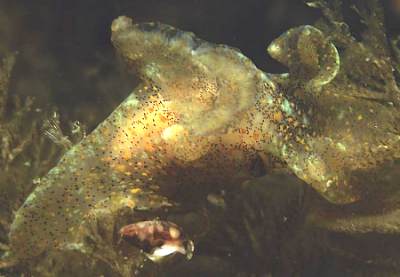
Bill -
I'm continually looking for nudibranchs that are new to me in our local waters. On November 9, 2003 I happened upon a species that I had not expected to find.
The Woods Hole Oceanographic Intstitute's pier pilings are usually covered in hydroids and are a great spot to find nudibranchs. On that day I was surprised to find the pilings covered in bryozoans rather than hydroids. I was disappointed but upon seeing an egg string that I was not familiar with I had my hopes up that I'd find a "new" nudibranch.
Sure enough I found what I believe is Thecacera pennigera. I found two specimens that day on opposite sides of the dive site. My limited research indicates that it had only been reported as far north as Florida on our western Atlantic coast. Of course this notorious hitchhiker is found in many places around the world. I have contacted local experts to find out if this find is indeed new to our area. I was wondering if it is likely that T. pennigera will establish a permanent residence in our colder waters. It is not uncommon for our waters to drop below freezing and ice over a bit.
Both specimens were approximately 25mm to 30mm long and found at approximately 10m.
Best wishes,
Alan Shepard
alan.chepard@snet.net
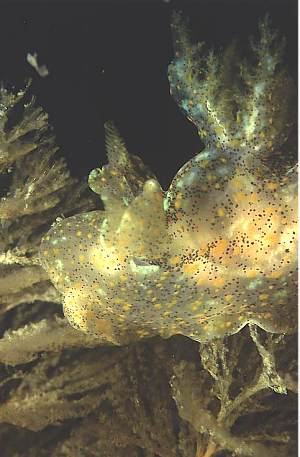
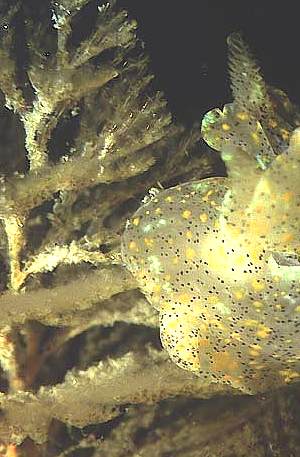
Dear Alan,
Thanks for this interesting record. It is indeed Thecacera pennigera and looks very like eastern Atlantic specimens with small orange spots and even smaller blue specks. I am interested in your mention that it is recorded from as 'far north as Florida on our western Atlantic coast' as the only record I know of this species in the western Atlantic is Marcus's 1957 record from Brazil. I would be grateful for a reference.
Concerning the chance of a permanent population. This appears to be one of those species which is dependent on a food source - the bryozoan Bugula - which is never permanent. All I can say is that since you have found it once there is always the chance it will appear again. What we don't know is whether the appearance in Woods Hole was the result of 'hitch-hiking' or was the result of 'natural' larval dispersal.
Thanks again for another interesting find
Best wishes
Bill Rudman
Thecacera pennigera from Korea
June 24, 2002
From: Dong Bum Koh
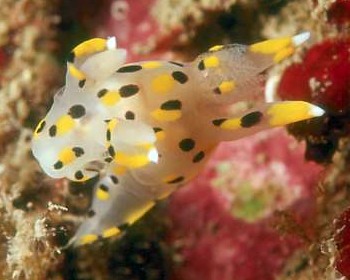
Dear, Bill!
Thanks for your comments. Here is a photo of Thecacera pennigera from Seogwipo. This is the first time I have encountered this species here so it maybe very rare.
Data:
Date: June 1 2002
Location: Mun islet in Seogwipo city, Cheju Island, S. Korea.
Depth: 20m, sandy mixed with rocky bottom
Photo by: Dong Bum, Koh
Best regards.
Dong Bum Koh
drkoh@seasee.co.kr
Koh, D.B., 2002 (Jun 24) Thecacera pennigera from Korea. [Message in] Sea Slug Forum. Australian Museum, Sydney. Available from http://www.seaslugforum.net/find/7316Dear Dong Bum,
Thanks for this interesting find. Many polycerids rarely encountered - but when found are often in quite large numbers. Perhaps it is because their food - arborescent bryozoans - are often members of that group of opportunistic organisms that settle on recently cleared substrates and quickly grow to maturity, before being replaced by some more slow growing, and more permanent competitor. This means that the nudibranchs planktonic larvae has to be there at the same time.
Best wishes,
Bill Rudman
Thecacera pennigera? from Japan
September 13, 2001
From: Jun Imamoto
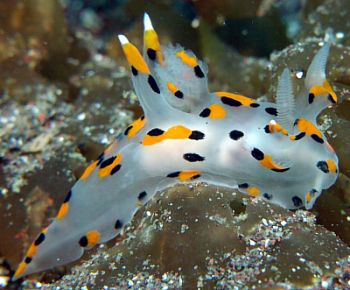
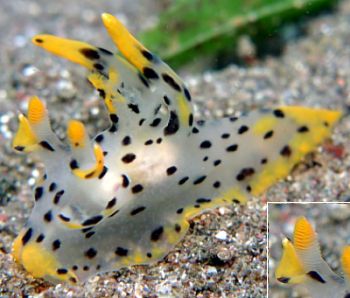
Dear Bill
Are these sea slugs both Thecacera pennigera? These sea slugs were seen in the same place at the same time.
But, I am at a loss to understand why they are both considerted the same species when their colour pattern is so different.
This sea slug can be seen in large numbers every year from March to June, so I will be able to be observe them better next year.
UPPER PHOTO: Izu Osezaki (Suruga Bay, Japan)
Depth: 18m., Size: about 25-30mm., May 4, 2001., Water temperature: 18C degrees.
LOWER PHOTO: Izu Osezaki (Suruga Bay, Japan)
Depth: 26m., Size: about 20-25mm., May 4, 2001., Water temperature: 18C degrees.
Best Regards,
Jun Imamoto
imamoto@wips.co.jp
Imamoto, J., 2001 (Sep 13) Thecacera pennigera? from Japan. [Message in] Sea Slug Forum. Australian Museum, Sydney. Available from http://www.seaslugforum.net/find/5212Dear Jun,
You certainly ask some interesting questions. If you look at my photo of an animal from Australia, at the top of the page, you will see its colour is a mixture of both your photos. It has orange, rather than yellow, spots as in your upper photo, but it has yellow-tipped rhinophores like your lower photo.
In Australia, this species varies in colour from animals like in your photos to ones which have a much more densely arranged cover of small orange and black spots, which is the colour form found in Europe. A good photo of it is in the Armstrong's message from New Zealand. I would be interested to know whether you also find this colour form in Japan.
The reason we consider all these colour forms to be the same species is that they seem to merge from one to the other. Perhaps further studies will show there are two species, but at present there is no evidence to support this idea.
Best wishes,
Bill Rudman
Re: Colour variation in Thecacera pennigera?
October 2, 1999
From: Loumar Wittebroodt
Could it be possible that species change colors, if not in the right water temperature or feeding ground?
Some tropical fish change their colour when the temperature rises or falls....
Loumar Wittebroodt
loumar@village.uunet.be
Wittebroodt, L., 1999 (Oct 2) Re: Colour variation in Thecacera pennigera?. [Message in] Sea Slug Forum. Australian Museum, Sydney. Available from http://www.seaslugforum.net/find/1389Dear Loumar,
I guess your question arises from the discussion occurring throughout the messages on Thecacera pennigera about the different colour forms found in different parts of the world.
Have a look at the page on opisthobranch colour patterns, where I discuss the many different ways that a slug is coloured and why. The important point is to know in each case how the colour is made. In some a slug while make its own pigment, no doubt under genetic control, but in many cases the pigments are secondarily acquired from their food, so environmental factors are involved. from my observations it seems that Discodoris lilacina can change colour in a few hours, perhaps by the use of pigment sacs, like cephalopods, but it has not been studied experimentally.
Thecacera pennigera would seem to be a species in which the colour pattern is genetically determined.
Best wishes,
Bill Rudman.
Eggs of Thecacera pennigera
September 5, 1999
From: René Lipmann
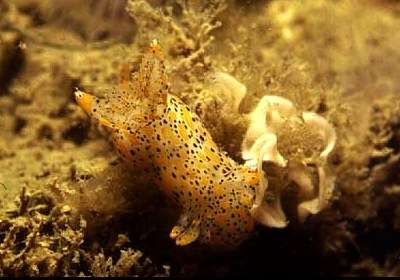
Bill,
find attached an image of a Thecacera pennigera with eggs.
Photo taken in the Oosterschelde, Goese Sas, the Netherlands. Depth was around 12, 13 meters. There where four animals with eggs.
Greetings,
René Lipmann
Diveteam Manta,
Amsterdam
lipmann@bvd.nl
Lipmann, R., 1999 (Sep 5) Eggs of Thecacera pennigera. [Message in] Sea Slug Forum. Australian Museum, Sydney. Available from http://www.seaslugforum.net/find/1283Thanks René,
Bill Rudman.
Thecacera pennigera from the Netherlands
August 31, 1999
From: René Lipmann
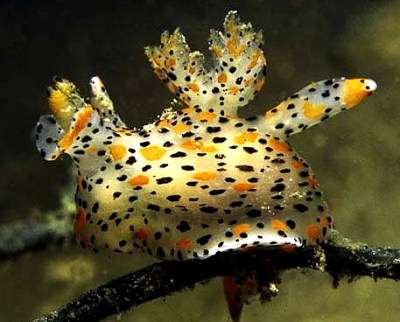
I like to show you a picture of Thecacera pennigera.
Location: Goese Sas, Oosterschelde, The Netherlands.
Date: 7 Aug. 1999, Depth: 12 meters
There where more of them also with eggs.
Greetings,
René Lipmann
Diveteam Manta,
Amsterdam
lipmann@bvd.nl
Lipmann, R., 1999 (Aug 31) Thecacera pennigera from the Netherlands. [Message in] Sea Slug Forum. Australian Museum, Sydney. Available from http://www.seaslugforum.net/find/1268Dear René,
Thanks for the photo. It is interesting to get an idea of the colour variation of this species in Europe. Any other photos of Sea Slugs are welcome, especially those showing feeding or egg-laying etc.
Best wishes,
Bill Rudman.
Thecacera pennigera from the Netherlands
August 8, 1999
From: Peter H. van Bragt
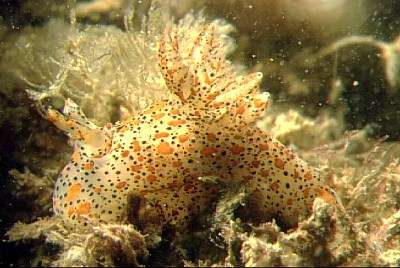
Dear Bill,
Here is a photo of Thecacera pennigera to add to the Netherlands' List.
Location: Plompe toren, de Oosterschelde, the Netherlands
Met vriendelijke groeten
(With best regards)
Peter H. van Bragt
Peter.vanBragt@ftn.hsbrabant.nl
van Bragt, P.H., 1999 (Aug 8) Thecacera pennigera from the Netherlands. [Message in] Sea Slug Forum. Australian Museum, Sydney. Available from http://www.seaslugforum.net/find/1167Dear Peter,
Your animal seem to fit the European colour pattern for this species as discussed by Bernard Picton in an earlier message. It would be interesting to know whether this species has populations which are as variable in colour as those from Australia & New Zealand in the other places where it has been recorded, such as Brazil, South Africa and California.
Best wishes,
Bill Rudman.
Thecacera pennigera from New Zealand
July 24, 1999
From: Ross & Diane Armstrong
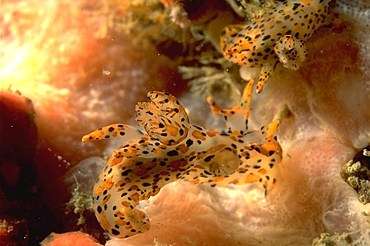
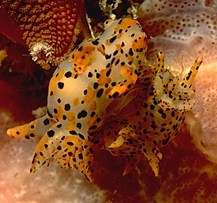
Dear Bill
Here is another nudibranch that our friend Glenn Edney found on the night dive in Whangarei Harbour. We have identified it as Thecacera pennigera from Neville Coleman's book. Unfortunately Glenn's camera was not working so the photos and by Diane and myself.
Kind regards
Ross and Diane Armstrong
ross@oceanwildlife.com
Armstrong, R. & D., 1999 (Jul 24) Thecacera pennigera from New Zealand. [Message in] Sea Slug Forum. Australian Museum, Sydney. Available from http://www.seaslugforum.net/find/1112Dear Ross & Diane,
Thanks for the great shots of Thecacera. By coincidence I have just been talking about Thecacera and Polycera hedgpethi being found in similar sea ports around the edge of the Indo-West Pacific, so your pictures are very timely.
Bill Rudman.
Re: Thecacera pennigera?
April 8, 1998
From: David W. Behrens
Hi Bill:
Love the forum and all its accomplishing. Where you find the time, I just don't know.
Where did you get the info that Thecacera pennigera occurs in California? News to me.
Sea Challengers NEW web site is up, and growing slowly (as I can afford it). Hope to add the Invertebrate Books this coming weekend. Our address is: www.seachallengers.com.
Stay in touch.
David W. Behrens
California
seachalleng@earthlink.net
Behrens, D.W., 1998 (Apr 8) Re: Thecacera pennigera?. [Message in] Sea Slug Forum. Australian Museum, Sydney. Available from http://www.seaslugforum.net/find/129Thanks for keeping me honest. I don't know any record of Thecacera from California either. I have removed it from the Distribution section. I think it crept in because the series of photos I was working with also had Polycera hedgepethi in them and that is another of these "wandering" polycerids which is definitely found in California as well as Australia, New Zealand and South Africa...Bill Rudman
Rudman, W.B., 1998 (Apr 8). Comment on Re: Thecacera pennigera? by David W. Behrens. [Message in] Sea Slug Forum. Australian Museum, Sydney. Available from http://www.seaslugforum.net/find/129Re: Thecacera pennigera?
March 26, 1998
From: Bernard Picton
Bill,
At last I've seen an antipodean Thecacera pennigera which looks exactly like our British ones - the ones David and Leanne photographed are very convincing!
Bernard Picton
bernard.picton.um@nics.gov.uk
Picton, B., 1998 (Mar 26) Re: Thecacera pennigera?. [Message in] Sea Slug Forum. Australian Museum, Sydney. Available from http://www.seaslugforum.net/find/128This opens up an interesting area of speculation. If the European ones have only this small spotted colour form while we have a variety of colour forms, is it not reasonable to suggest that the species is a native of the Western Pacific and the Atlantic population is the immigrant population descended from some small-spotted individuals which hitched a ride there on the bottom of some explorer's boat?.. Bill Rudman
Rudman, W.B., 1998 (Mar 26). Comment on Re: Thecacera pennigera? by Bernard Picton. [Message in] Sea Slug Forum. Australian Museum, Sydney. Available from http://www.seaslugforum.net/find/128Thecacera pennigera?
December 19, 1997
From: David & Leanne Atkinson
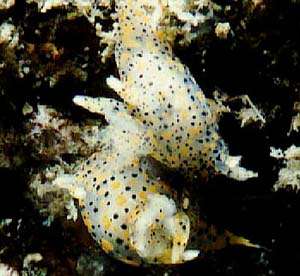
Bill,
Could you see if the attached nudi is Thecacera pennigera? We found heaps at Fly Point, Port Stephens, New South Wales, last weekend. Ours have more yellow and dark blue spots with a translucent cream body. They have been around for about 4 months now. I haven't noticed them before in my 13 years of diving Fly. Wayne may have? We have been diving in different areas this year, though. Sorry the photo is not the best. We will try to get some better ones over Christmas. I may resort to taking a "background" with me.
Thanks,
David & Leanne Atkinson.
atkin@hunterlink.net.au
Atkinson, D. & L., 1997 (Dec 19) Thecacera pennigera?. [Message in] Sea Slug Forum. Australian Museum, Sydney. Available from http://www.seaslugforum.net/find/127Yes its Thecacera pennigera. originally described from England but now known from many parts of the world. It feeds on bryozoans which foul the bottom of ships, so it possibly has spread around the world in the last 150 years. Where it originated is still a mystery. Bill Rudman
Rudman, W.B., 1997 (Dec 19). Comment on Thecacera pennigera? by David & Leanne Atkinson. [Message in] Sea Slug Forum. Australian Museum, Sydney. Available from http://www.seaslugforum.net/find/127